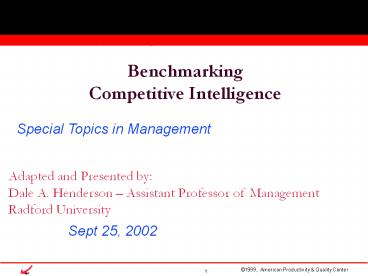Benchmarking Competitive Intelligence - PowerPoint PPT Presentation
1 / 18
Title:
Benchmarking Competitive Intelligence
Description:
What best practice companies offer for CI products. Questions to ask when designing CI products ... be designed and evolve with input from users, and ... – PowerPoint PPT presentation
Number of Views:917
Avg rating:3.0/5.0
Title: Benchmarking Competitive Intelligence
1
Benchmarking Competitive Intelligence
Special Topics in Management
Adapted and Presented by Dale A. Henderson
Assistant Professor of Management Radford
University
Sept 25, 2002
2
Agenda
- What is CI?
- What do cool CI departments look like?
- Developing CI units
- Companies with effective CI units
- Structure of CI departments
- What best practice companies offer for CI
products - Questions to ask when designing CI products
- How to recognize whether you have the right
products - How can solos work better with CI units?
3
Definition of Competitive Intelligence
- Competitive intelligence (CI) is the process
of monitoring the competitive environment. CI - enables senior managers in companies of all
sizes to make informed decisions about every- - thing from marketing, RD, and investing
tactics - to long-term business strategies. Effective
CI is - a continuous process involving the legal and
ethical collection of information, analysis that
doesn't avoid unwelcome conclusions, and
controlled dissemination of actionable
intelligence to decision makers. - Source Society of Competitive Intelligence
Professionals
4
Definition of Competitive Intelligence
- Competitive intelligence is a systematic
program for gathering and analyzing information
about your competitors activities and general
business trends to further your own companys
goal. - Source Larry Kahaner,
Competitive Intelligence
5
What Makes a Good Competitive Intelligence
Program?
- 1. Evolving, yet stable, CI infrastructures
- 2. Decentralized -- coordinated networks
- 3. Responsive IT system operating as a learning
system - 4. Strong links between tactical and strategic CI
- 5. Customer-feedback-implementation linkage
- 6. Hypothesis-driven recommendations-improves
decision making - 7. Institutionalizing intelligence cultures with
appropriate rewards - 8. FIICH Model Focus, Implement,
Institutionalize, Change, Hone - 9. TAP IN Model Teams, Allocation, Planning,
Interaction, Networks
6
Companies with Good CI Programs
- Bell Atlantic Xerox
- Eastman Kodak Skandia
- Ford SDG
- Merck Amoco
- Pacific Enterprises Sequent
- American Express Boehringer Ingelheim
- Procter Gamble Dow Chemical
- MetLife SBC Operations
7
Five Keys to Developing a CI Unit
- 1. Establish the intelligence process first how
you - will operate.
- 2. Begin with clearly defined roles and
- responsibilities.
- 3. Establish a seamless intelligence
communication - strategy within the company.
- 4. Build awareness slowly with key successes.
- 5. Dont get caught in the activity trap of
answering - everyones questions.
8
Amocos CI Organizational Structure
9
Boehringer Ingelheim CI Organizational Structure
10
CI Information Request
11
CI Product Development
- Data transformed becomes information.
- Information transformed becomes intelligence.
- Intelligence transformed becomes competitive
advantage.
Senior
Senior
Business Intelligence Functions
Management
Management
Function
Function
Analysis
and
Implications
12
Types of Projects/Products
- Types of Projects/Products
- Proprietary researching, reporting, and
assessment of the implications of competitors
activities and operational industry trends - Characterization of the external competitive
environment and analysis of key competitors based
on proprietary and publicly available information
resources such as - comparative assessments of competitor performance
and gaps - implications of competitor strategies,
performance and drivers of success and - benchmarking studies on focused competitive
issues - Training for competitor response modeling, ethics
and counterintelligence - Development of proprietary databases of experts,
financial data, and analytically based knowledge
products
13
Determining the CI Product
- Questions to ask
- What variety of products should be offered to
meet the needs of our customers? - For each CI product, what level of resources
should be invested? - What benefits will be derived from each
portfolio? - What other parts of the organization should you
partner with to design and implement the CI
product?
14
Four Keys to Developing Products
- CI Products Should
- Assist managers in solving a program,
- Impart to the user CI knowledge skills,
- be designed and evolve with input from users, and
- stretch the capabilities in the CI knowledge
domain.
15
How Do You Know If You Have the Right Products?
- An open-access culture is fostered.
- Geographical, cultural and time barriers are
reduced. - Tacit knowledge becomes explicit knowledge.
- Institutional memory is created.
- Managers trust and use CI products to make
decisions. - CI knowledge use becomes a way of doing business.
- The CI knowledge process becomes fun.
16
Some of the Roles Employees Can Play in CI
- Information research for Intelligence analysis
- Identification of intelligence (human) sources
- Verification of human source reporting
- Production of value-added newsletters
- Maintain intelligence databases
17
What CI Products Can Employees Assist With?
- Current Intelligence
- Basic Intelligence
- Technical Intelligence
- Early-Warning Intelligence
- Estimated Intelligence
- Work Group Intelligence
- Targeted Intelligence
- Crisis Intelligence
- Foreign Intelligence
- Counterintelligence
18
Next Steps!
- Decide what part you and/or your firm should play
in the CI process. - Think about what value you and your firm can
bring to the CI process. - Present and discuss your plans with senior
management or the CI manager if you have one. - Partner with other groups to achieve success.
Remember, no one group can do it all!































